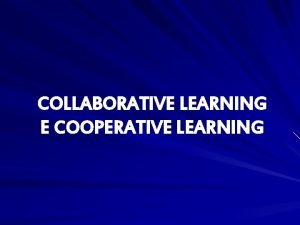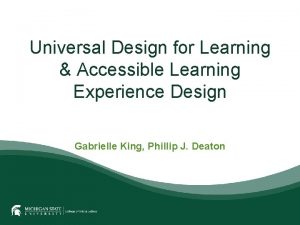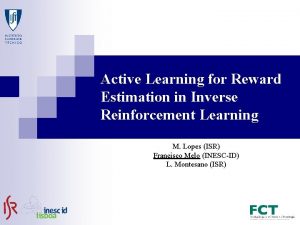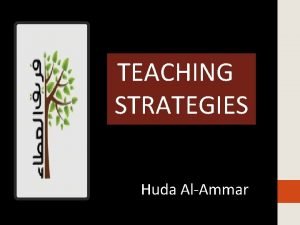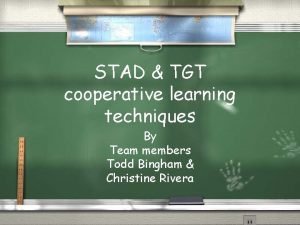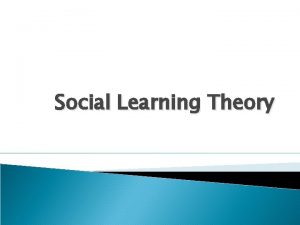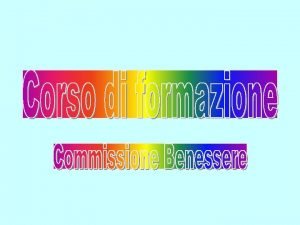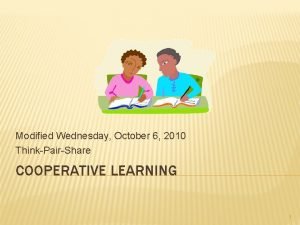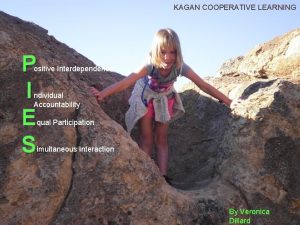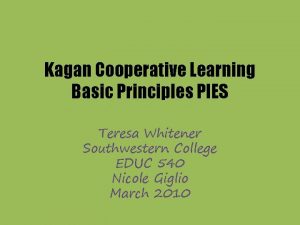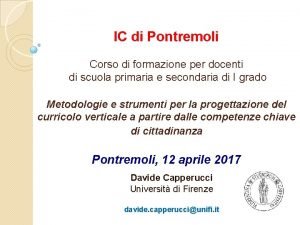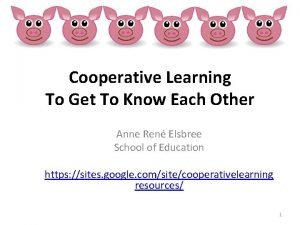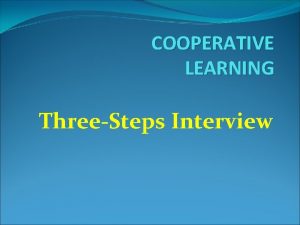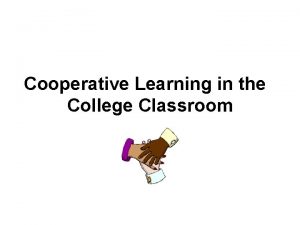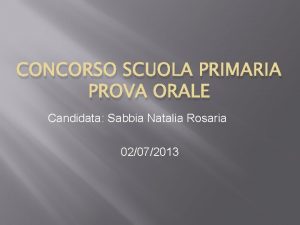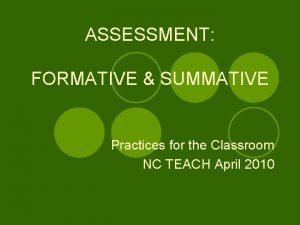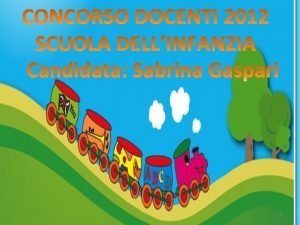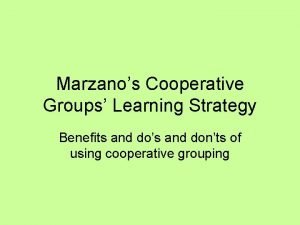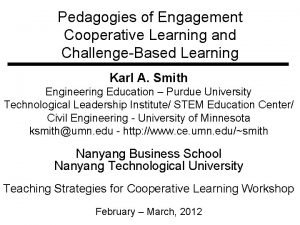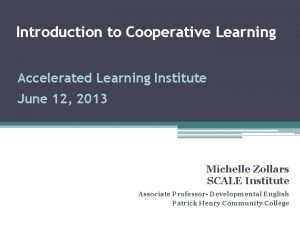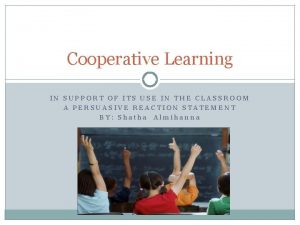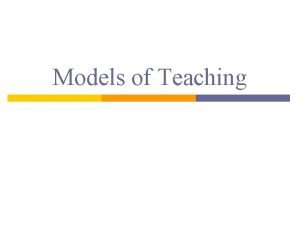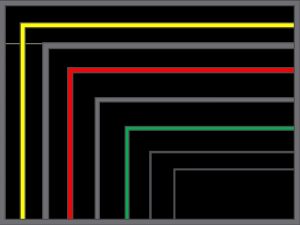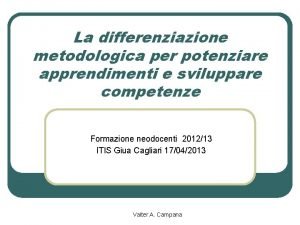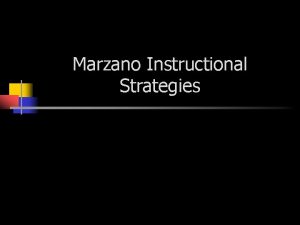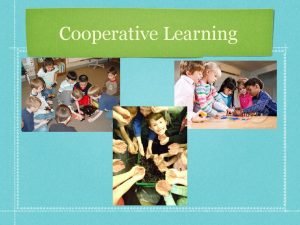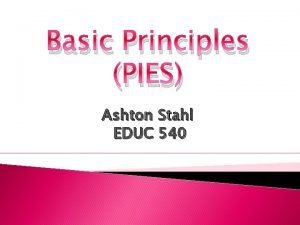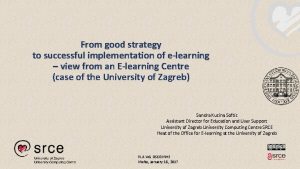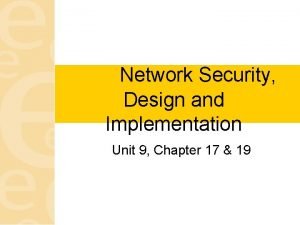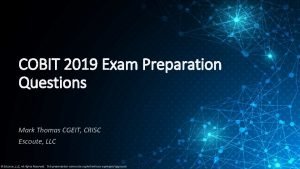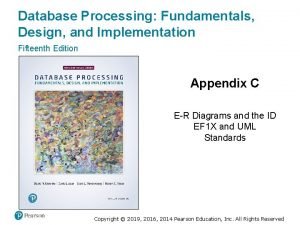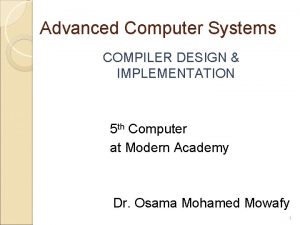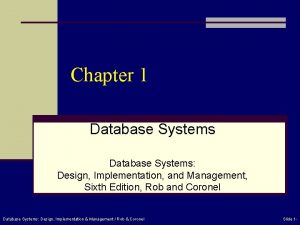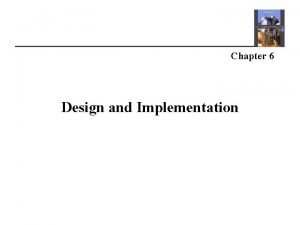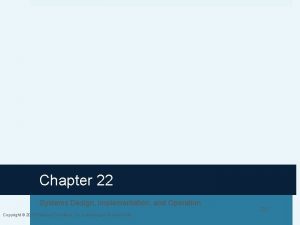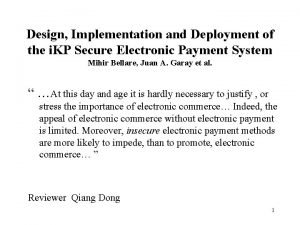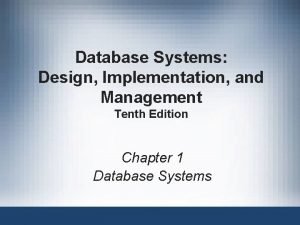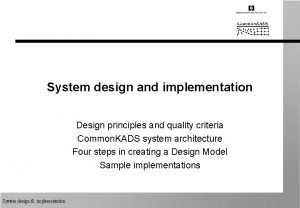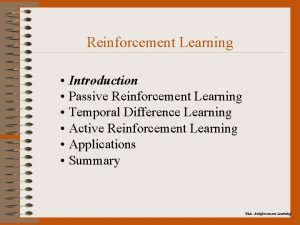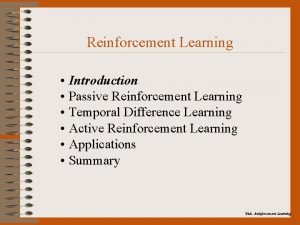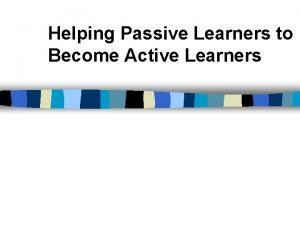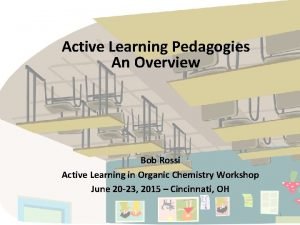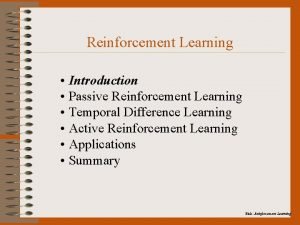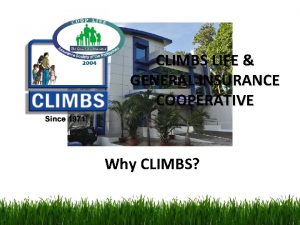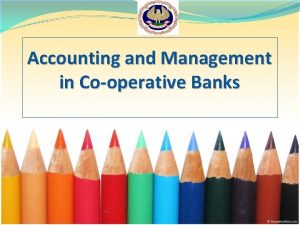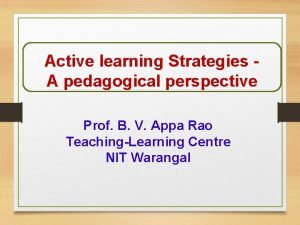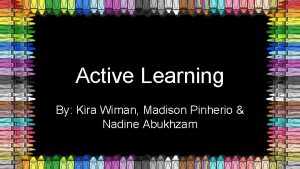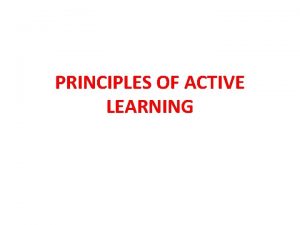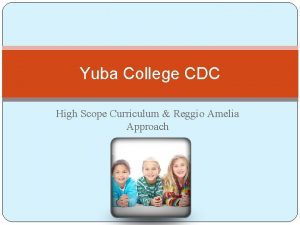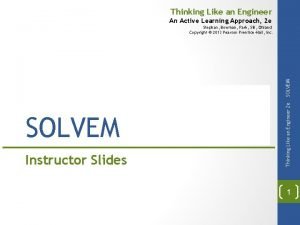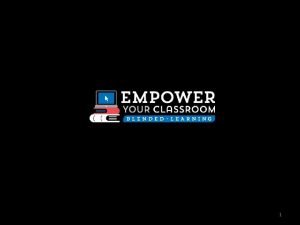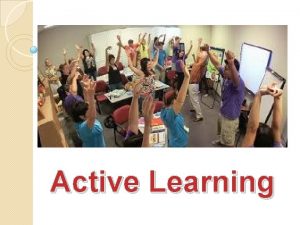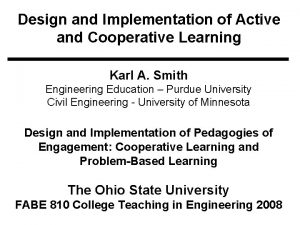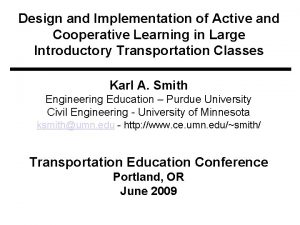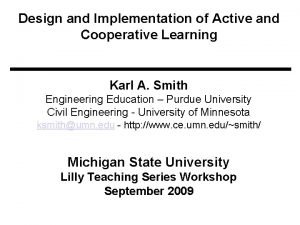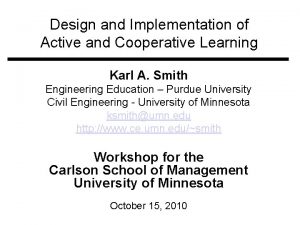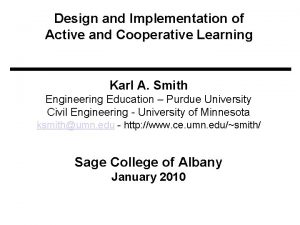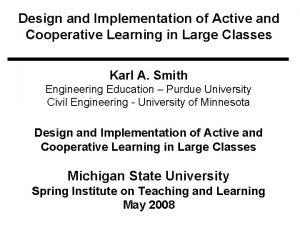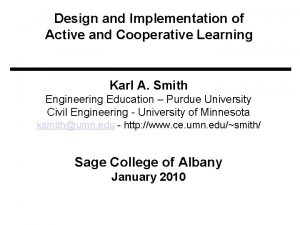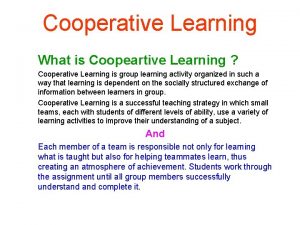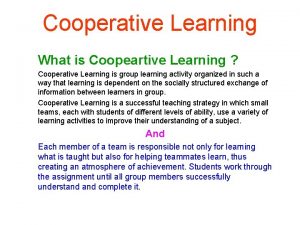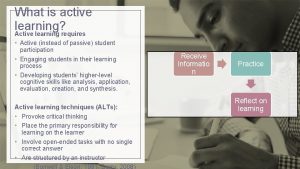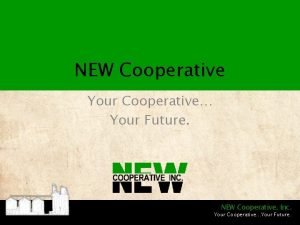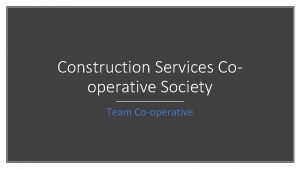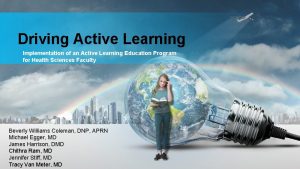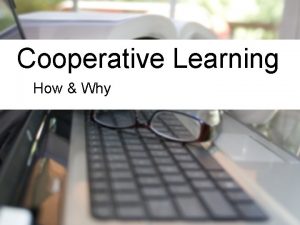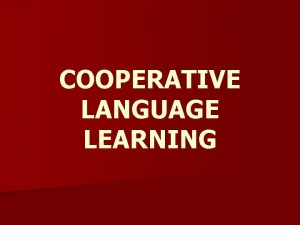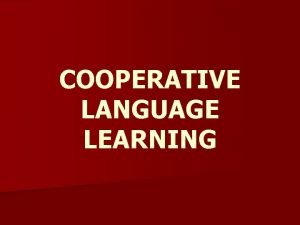Design and Implementation of Active and Cooperative Learning



































































- Slides: 67

Design and Implementation of Active and Cooperative Learning in Large Classes - Design Details Karl A. Smith Engineering Education – Purdue University Civil Engineering - University of Minnesota ksmith@umn. edu - http: //www. ce. umn. edu/~smith/ Michigan State University Spring Institute on Teaching and Learning May 2009

Workshop Layout • Welcome & Overview • Guiding Questions & Participant Survey • How People Learn Framework • Design Project – Pr. BL example • Backward Design Approach – Course, Class Session, and Learning Module Design: From Objectives and Evidence to Instruction • Wrap-up 2

Effective Course Design Bloom’s Taxonomy ABET EC 2000 (Felder & Brent, 1999) Goals and Objectives Course-specific goals & objectives Technology Cooperative learning Students Instruction Lectures Labs Classroom assessment techniques Assessment Other experiences Tests 3 Other measures

A Self-Directed Guide to Designing Courses for Significant Learning L. Dee Fink. 2003. Creating significant learning experiences. Jossey-Bass. 4

Backward Design Wiggins & Mc. Tighe Stage 1. Identify Desired Results Stage 2. Determine Acceptable Evidence Stage 3. Plan Learning Experiences and Instruction Wiggins, Grant and Mc. Tighe, Jay. 1998. Understanding by Design. Alexandria, VA: ASCD 5

Worksheet 1 Worksheet for Designing a Course/Class Session/Learning Module Learning Goals for Course/Session/Module: Ways of Assessing Actual Teaching-Learning Helpful Resources: This Kind of Learning: Activities: (e. g. , people, things) 1. 2. 3. 4. 5. 6

Guiding Questions for the Workshop Ø How do you design and implement active and cooperative learning (ACL) in large classes? Ø What are some of the guiding principles underlying the design of ACL? Ø Questions based on Backward Design Model: Ø What is worthy and requiring of student’s understanding? Ø What is evidence of understanding? Ø What learning experiences and teaching promote understanding, interest, and excellence? 7

Knowledge Probe • ACL Knowledge Probe • Example from MOT 8221 • What would you like to know about the students in your courses? 8

Survey of Participants • Familiar with active/cooperative learning (ACL) literature? • Experienced ACL as a learner? • Teach / Taught using ACL? • Designed or redesigned a course to incorporate ACL? • ACL/PBL Workshop(s)? – – University of Minnesota Johnson & Johnson CL Mc. Master University of Delaware Other Workshops/conferences? 9

10

MOT 8221 – Spring 2007 – 27/30 PM Q 1 IE/OR Q 6 PMI-PMBOK Q 2 Mod/Sim Q 7 KM Q 3 CAS Q 8 Leadership Q 4 Mgmt. Sci Q 9 Eng. Sys Q 5 6 Sigma Q 10 11

MOT 8221 – Spring 2007 – 27/30 Spread Q 1 DB Q 5 PM Q 2 Prog Q 6 Stat Q 3 KM/ES Q 7 Mod/Sim Q 4 12

Project-Based Cooperative Learning Karl A. Smith Engineering Education – Purdue University Civil Engineering - University of Minnesota ksmith@umn. edu http: //www. ce. umn. edu/~smith Tower Design 13

Cooperative Learning is instruction that involves people working in teams to accomplish a common goal, under conditions that involve both positive interdependence (all members must cooperate to complete the task) and individual and group accountability (each member is accountable for the complete final outcome). Key Concepts • Positive Interdependence • Individual and Group Accountability • Face-to-Face Promotive Interaction • Teamwork Skills • Group Processing

Formal Cooperative Learning – Types of Tasks 1. Jigsaw – Learning new conceptual/procedural material 2. Peer Composition or Editing 3. Reading Comprehension/Interpretation 4. Problem Solving, Project, or Presentation 5. Review/Correct Homework 6. Constructive Academic Controversy 7. Group Tests

Challenged-Based Learning • • • Problem-based learning Case-based learning Project-based learning Learning by design Inquiry learning Anchored instruction John Bransford, Nancy Vye and Helen Bateman. Creating High-Quality Learning Environments: Guidelines from Research on How People Learn 16

Professor's Role in Formal Cooperative Learning 1. Specifying Objectives 2. Making Decisions 3. Explaining Task, Positive Interdependence, and Individual Accountability 4. Monitoring and Intervening to Teach Skills 5. Evaluating Students' Achievement and Group Effectiveness 17

Decisions, Decisions Group size? Group selection? Group member roles? How long to leave groups together? Arranging the room? Providing materials? Time allocation? 18

Formal Cooperative Learning Task Groups Perkins, David. 2003. King Arthur's Round Table: How collaborative conversations create smart organizations. NY: Wiley.

Problem Based Cooperative Learning Format TASK: Solve the problem(s) or Complete the project. INDIVIDUAL: Estimate answer. Note strategy. COOPERATIVE: One set of answers from the group, strive for agreement, make sure everyone is able to explain the strategies used to solve each problem. EXPECTED CRITERIA FOR SUCCESS: Everyone must be able to explain the strategies used to solve each problem. EVALUATION: Best answer within available resources or constraints. INDIVIDUAL ACCOUNTABILITY: One member from your group may be randomly chosen to explain (a) the answer and (b) how to solve each problem. EXPECTED BEHAVIORS: Active participating, checking, encouraging, and elaborating by all members. INTERGROUP COOPERATION: Whenever it is helpful, check procedures, 20 answers, and strategies with another group.

Engineering Design Project The engineering method is design under constraints – Wm. Wulf, President, National Academy of Engineering The engineering method is the use of heuristics to cause the best change in a poorly understood situation within the available resources – Billy Koen, Mechanical Engineering Professor, UT-Austin, author Discussion of the Method 21

Project Based Learning (Pr. BL) Example - Design • Experience Pr. BL: – Participate in the design task – Metacognitive Reflection • Attend to what the group is doing. • Pay attention to what the instructor is doing. 22

Team Member Roles • Task Recorder • Process Recorder • Materials Manager 23

Design objective Design and build a tower that can support a concentrated load (text book) at a height of least 35 cm. The tower is built from index cards and office tape. Design rules Materials are 100 index cards and one roll of office tape Cards can be folded but not torn No piece of tape can be longer than 2 inches Tower cannot be taped to the floor, ceiling, or any other object Tower must be in one piece, and easily transported in one hand Time to design and build: 20 minutes Height is measured from the ground to the lowest corner of the book placed on top Tower must support book for at least 10 seconds before the measurement is made Room must be cleaned up before measurements are made.

Group Processing Plus/Delta Format Plus (+) Things That Group Did Well Delta (∆) Things Group Could Improve

Teamwork & Project Management Heuristics-Examples • Identify the weak link and Allocate resources to the weak link • Freeze the design--at some stage in the project (when about 75% of the time or resources are used up) the design must be frozen • Discuss the process and ask meta-level questions, e. g. , What are we doing? Why are we doing it? How does it help? 26

Problem-Based Learning START Apply it Problem posed Learn it Identify what we need to know 27

Subject-Based Learning START Given problem to illustrate how to use it Told what we need to know Normative Professional Curriculum: Learn it 1. Teach the relevant basic science, 2. Teach the relevant applied science, and 3. Allow for a practicum to connect the science to actual practice. 28

Problem-Based Learning (PBL) Problem-based learning is the learning that results from the process of working toward the understanding or resolution of a problem. The problem is encountered first in the learning process B Barrows and Tamlyn, 1980 Core Features of PBL • Learning is student-centered • Learning occurs in small student groups • Teachers are facilitators or guides • Problems are the organizing focus and stimulus for learning • Problems are the vehicle for the development of clinical problemsolving skills • New information is acquired through self-directed learning 29

Cooperative Learning is instruction that involves people working in teams to accomplish a common goal, under conditions that involve both positive interdependence (all members must cooperate to complete the task) and individual and group accountability (each member is accountable for the complete final outcome). Key Concepts • Positive Interdependence • Individual and Group Accountability • Face-to-Face Promotive Interaction • Teamwork Skills • Group Processing

Modeling in its broadest sense is the cost-effective use of something in place of something else for some cognitive purpose (Rothenberg, 1989). A model represents reality for the given purpose; the model is an abstraction of reality in the sense that it cannot represent all aspects of reality. Any model is characterized by three essential attributes: (1) Reference: It is of something (its "referent"); (2) Purpose: It has an intended cognitive purpose with respect to its referent; (3) Cost-effectiveness: It is more costeffective to use the model for this purpose than to use the referent itself. Rothenberg, J. 1989. The nature of modeling. In L. E. Widman, K. A. Laparo & N. R. Nielson, Eds. , Artificial intelligence, simulation and modeling. New York: Wiley

Modeling Heuristics Ravindran, Phillips, and Solberg (1987): 1. 2. 3. 4. 5. 6. 7. 8. 9. 10. Do not build a complicated model when a simple one will suffice. Beware of molding the problem to fit the technique. The deduction phase of modeling must be conducted rigorously. Models should be validated prior to implementation. A model should never be taken too literally. A model should neither be pressed to do, nor criticized for failing to do, that for which it was never intended. Beware of overselling a model. Some of the primary benefits of modeling are associated with the process of developing the model. A model cannot be any better than the information that goes into it. Models cannot replace decision makers.

Engineering = Design in a major sense is the essence of engineering; it begins with the identification of a need and ends with a product or system in the hands of a user. It is primarily concerned with synthesis rather than the analysis which is central to engineering science. Design, above all else, distinguishes engineering from science (Hancock, 1986, National Science Foundation Workshop). Design defines engineering. It's an engineer's job to create new things to improve society. It's the University's obligation to give students fundamental education in design (William Durfee, ME, U of Minnesota, Minnesota Technolog, Nov/Dec 1994).

Engineering Design Engineering design is a systematic, intelligent process in which designers generate, evaluate, and specify concepts for devices, systems, or processes whose form and function achieve clients’ objectives or users’ needs while satisfying a specified set of constraints. Engineering Design Thinking, Teaching, and Learning -- http: //www. asee. org/about/publications/jee/upload/2005 jee_sample. htm 34

Skills often associated with good designers – the ability to: • tolerate ambiguity that shows up in viewing design as inquiry or as an iterative loop of divergent-convergent thinking; • maintain sight of the big picture by including systems thinking and systems design; • handle uncertainty; • make decisions; • think as part of a team in a social process; and • think and communicate in the several languages of design. Engineering Design Thinking, Teaching, and Learning -- http: //www. asee. org/about/publications/jee/upload/2005 jee_sample. htm 35

http: //www. businessweek. com /magazine/content/04_20/b 38 83001_mz 001. htm Time, April 2005 36

37 http: //www. stanford. edu/group/dschool/big_picture/our_vision. html

Design Thinking Discipline Thinking Ideo's five-point model for strategizing by design: Hit the Streets Recruit T-Shaped People Build to Think The Prototype Tells a Story Design Is Never Done Tom Friedman Horizontalize Ourselves 38 AAC&U College Learning For the New Global Century

Design Thinking Discipline Thinking Tom Friedman Horizontalize Ourselves CQ+PQ>IQ 39 AAC&U College Learning For the New Global Century

Effective Course Design Bloom’s Taxonomy ABET EC 2000 (Felder & Brent, 1999) Goals and Objectives Course-specific goals & objectives Technology Cooperative learning Students Instruction Lectures Labs Classroom assessment techniques Assessment Other experiences Tests 40 Other measures

A Self-Directed Guide to Designing Courses for Significant Learning L. Dee Fink. 2003. Creating significant learning experiences. Jossey-Bass. 41

Backward Design Wiggins & Mc. Tighe Stage 1. Identify Desired Results Stage 2. Determine Acceptable Evidence Stage 3. Plan Learning Experiences and Instruction Wiggins, Grant and Mc. Tighe, Jay. 1998. Understanding by Design. Alexandria, VA: ASCD 42

Backward Design Approach: • Desired Results (Outcomes, Objectives, Learning Goals) – 5 minute university • Evidence (Assessment) – Learning Taxonomies • Plan Instruction – Cooperative Learning Planning Format & Forms 43

Worksheet 1 Worksheet for Designing a Course/Class Session/Learning Module Learning Goals for Course/Session/Learning Module: Ways of Assessing Actual Teaching-Learning Helpful Resources: This Kind of Learning: Activities: (e. g. , people, things) 1. 2. 3. 4. 5. 6. 44

45

Backward Design Stage 1. Identify Desired Results Filter 1. To what extent does the idea, topic, or process represent a big idea or having enduring value beyond the classroom? Filter 2. To what extent does the idea, topic, or process reside at the heart of the discipline? Filter 3. To what extent does the idea, topic, or process require uncoverage? Filter 4. To what extent does the idea, topic, or process offer potential for engaging students? 46

Worksheet 1 Worksheet for Designing a Course/Class Session/Learning Module Learning Goals for Course/Session/Learning Module: Ways of Assessing Actual Teaching-Learning Helpful Resources: This Kind of Learning: Activities: (e. g. , people, things) 1. 2. 3. 4. 5. 6. 47

Backward Design Approach: • Desired Results (Outcomes, Objectives, Learning Goals) – 5 minute university • Evidence (Assessment) – Learning Taxonomies • Plan Instruction – Cooperative Learning Planning Format & Forms 48

Backward Design Stage 2. Determine Acceptable Evidence Types of Assessment Quiz and Test Items: Simple, content-focused test items Academic Prompts: Open-ended questions or problems that require the student to think critically Performance Tasks or Projects: Complex challenges that mirror the issues or problems faced by graduates, they are authentic 49

Understanding Stage 1. Identify Desired Results Focus Question: What does it mean to “understand”? Stage 2. Determine Acceptable Evidence Focus Questions: “How will we know if students have achieved the desired results and met the standards? What will we accept as evidence of student understanding and proficiency (Wiggins & Mc. Tighe) 50

Understanding Misunderstanding A Private Universe – 21 minute video available from www. learner. org Also see Minds of our own (Annenberg/CPB Math and Science Collection – www. learner. org) 1. Can we believe our eyes? 2. Lessons from thin air 3. Under construction 4. Teaching & Understanding - http: //www. daimi. au. dk/~brabrand/short-film/index-gv. html 51

Some Important Principles About Learning and Understanding The first important principle about how people learn is that students come to the classroom with preconceptions about how the world works which include beliefs and prior knowledge acquired through various experiences. The second important principle about how people learn is that to develop competence in an area of inquiry, students must: (a) have a deep foundation of factual knowledge, (b) understand facts and ideas in the context of a conceptual framework, and (c) organize knowledge in ways that facilitate retrieval and application. A third critical idea about how people learn is that a “metacognitive” approach to instruction can help students learn to take control of their own learning by defining learning goals and monitoring their progress in achieving them. Jim Pellegrino – Rethinking and redesigning curriculum, instruction and assessment: What contemporary research and theory suggests 52

Taxonomies Bloom’s taxonomy of educational objectives: Cognitive Domain (Bloom & Krathwohl, 1956) A taxonomy for learning, teaching, and assessing: A revision of Bloom’s taxonomy of educational objectives (Anderson & Krathwohl, 2001). Evaluating the quality of learning: The SOLO taxonomy (Biggs & Collis, 1982) Facets of understanding (Wiggins & Mc. Tighe, 1998) Taxonomy of significant learning (Dee Fink, 2003) 53

The Six Major Levels of Bloom's Taxonomy of the Cognitive Domain (with representative behaviors and sample objectives) Knowledge. Remembering information Define, identify, label, state, list, match Identify the standard peripheral components of a computer Write the equation for the Ideal Gas Law Comprehension. Explaining the meaning of information Describe, generalize, paraphrase, summarize, estimate In one sentence explain the main idea of a written passage Describe in prose what is shown in graph form Application. Using abstractions in concrete situations Determine, chart, implement, prepare, solve, use, develop Using principles of operant conditioning, train a rate to press a bar Derive a kinetic model from experimental data Analysis. Breaking down a whole into component parts Points out, differentiate, distinguish, discriminate, compare Identify supporting evidence to support the interpretation of a literary passage Analyze an oscillator circuit and determine the frequency of oscillation Synthesis. Putting parts together to form a new and integrated whole Create, design, plan, organize, generate, write Write a logically organized essay in favor of euthanasia Develop an individualized nutrition program for a diabetic patient Evaluation. Making judgments about the merits of ideas, materials, or phenomena Appraise, critique, judge, weigh, evaluate, select Assess the appropriateness of an author's conclusions based on the evidence given Select the best proposal for a proposed water treatment plant 54

55 (Anderson & Krathwohl, 2001).

A taxonomy for learning, teaching, and assessing: A revision of Bloom’s taxonomy of educational objectives (Anderson & Krathwohl, 2001). • The Knowledge Dimension – Factual Knowledge – Conceptual Knowledge – Procedural Knowledge – Metacognitive Knowledge 56

Cognitive Process Dimension • Remember – Recognizing – Recalling • Understand – Interpreting – Exemplifying – Summarizing – Inferring – Comparing – Explaining 57

Cognitive Process Dimension-2 • Apply – Executing – Implementing • Analyze – Differentiating – Organizing – Attributing • Evaluate – Checking – Critiquing • Create – Generating – Planning – Producing 58

The Cognitive Process Dimension Remember Understand Apply Analyze Evaluate Create Factual Knowledge – The basic The Knowledge Dimension elements that students must know to be acquainted with a discipline or solve problems in it. a. Knowledge of terminology b. Knowledge of specific details and elements Conceptual Knowledge – The interrelationships among the basic elements within a larger structure that enable them to function together. a. Knowledge of classifications and categories b. Knowledge of principles and generalizations c. Knowledge of theories, models, and structures Procedural Knowledge – How to do something; methods of inquiry, and criteria for using skills, algorithms, techniques, and methods. a. Knowledge of subject-specific skills and algorithms b. Knowledge of subject-specific techniques and methods c. Knowledge of criteria for determining when to use appropriate procedures Metacognitive Knowledge – Knowledge of cognition in general as well as awareness and knowledge of one’s own cognition. a. Strategic knowledge b. Knowledge about cognitive tasks, including appropriate contextual and conditional knowledge c. Self-knowledge 59 Imbrie and Brophy, 2007

Facets of Understanding Wiggins & Mc. Tighe, 1998, page 44 When we truly understand, we Can explain Can interpret Can apply Have perspective Can empathize Have self-knowledge 60

61

62

Backward Design Approach: • Desired Results (Outcomes, Objectives, Learning Goals) – 5 minute university • Evidence (Assessment) – Learning Taxonomies • Plan Instruction – Cooperative Learning Planning Format & Forms 63

Backward Design Stage 3. Plan Learning Experiences & Instruction • What enabling knowledge (facts, concepts, and principles) and skills (procedures) will students need to perform effectively and achieve desired results? • What activities will equip students with the needed knowledge and skills? • What will need to be taught and coached, and how should it be taught, in light of performance goals? • What materials and resources are best suited to accomplish these goals? • Is the overall design coherent and effective? 64

Worksheet 1 Worksheet for Designing a Course/Class Session/Learning Module Learning Goals for Course/Session/Learning Module: Ways of Assessing Actual Teaching-Learning Helpful Resources: This Kind of Learning: Activities: (e. g. , people, things) 1. 2. 3. 4. 5. 65

66

67
 Collaborative learning vs cooperative learning
Collaborative learning vs cooperative learning Accessible learning experience design and implementation
Accessible learning experience design and implementation Active and passive learners
Active and passive learners Active learning reinforcement learning
Active learning reinforcement learning Cooperative vs collaborative learning
Cooperative vs collaborative learning Tgt cooperative learning
Tgt cooperative learning Social definition
Social definition Pedagogia non direttiva rogers
Pedagogia non direttiva rogers Think pair share cooperative learning
Think pair share cooperative learning Kagan pies
Kagan pies Kagan pies
Kagan pies Compito di realtà esempio
Compito di realtà esempio Pigs face cooperative learning
Pigs face cooperative learning Three step interview kagan
Three step interview kagan Example of cooperative learning
Example of cooperative learning Griglia di osservazione cooperative learning
Griglia di osservazione cooperative learning Cooperative vs collaborative learning
Cooperative vs collaborative learning Griglia di osservazione cooperative learning
Griglia di osservazione cooperative learning Marzano cooperative learning
Marzano cooperative learning Formal cooperative learning
Formal cooperative learning Cooperative learning institute
Cooperative learning institute Types of cooperative learning
Types of cooperative learning Types of learning model
Types of learning model Approaches of cooperative learning
Approaches of cooperative learning Classificazione delle metodologie didattiche
Classificazione delle metodologie didattiche Marzano strategies
Marzano strategies Formal cooperative learning
Formal cooperative learning Cooperative learning round robin
Cooperative learning round robin Cooperative learning pies
Cooperative learning pies Cuadro comparativo de e-learning b-learning y m-learning
Cuadro comparativo de e-learning b-learning y m-learning And or boolean
And or boolean Membrane structures that function in active transport
Membrane structures that function in active transport Primary active transport vs secondary active transport
Primary active transport vs secondary active transport E learning implementation strategy
E learning implementation strategy Network security design
Network security design Cognitive walkthrough vs heuristic evaluation
Cognitive walkthrough vs heuristic evaluation Cobit foundation exam question
Cobit foundation exam question Aka.ms/deploymentplans
Aka.ms/deploymentplans Fundamentals of design
Fundamentals of design Channel design and implementation
Channel design and implementation Advanced compiler design and implementation
Advanced compiler design and implementation Database system design implementation and management
Database system design implementation and management Distributed shared memory
Distributed shared memory Design and implementation of data plane.
Design and implementation of data plane. Host target development in software engineering
Host target development in software engineering System design implementation and operation
System design implementation and operation Design and implementation of e secure transaction
Design and implementation of e secure transaction Database systems design implementation
Database systems design implementation Implementation design principles
Implementation design principles Active and passive reinforcement learning
Active and passive reinforcement learning What is active and passive reinforcement learning
What is active and passive reinforcement learning Passive and active learning
Passive and active learning What is the difference between passive and active learning
What is the difference between passive and active learning Passive learner
Passive learner What is active and passive reinforcement learning
What is active and passive reinforcement learning Climbs life and general insurance cooperative
Climbs life and general insurance cooperative Cooperative advantages and disadvantages
Cooperative advantages and disadvantages Badilika cooperative society ltd
Badilika cooperative society ltd Do cooperative banks maintain crr and slr
Do cooperative banks maintain crr and slr Active learning strategies to promote critical thinking
Active learning strategies to promote critical thinking Active learning definition
Active learning definition Active learning definition
Active learning definition Principles of active learning
Principles of active learning Principles of active learning
Principles of active learning Montessori active learning
Montessori active learning Transductive reasoning psychology
Transductive reasoning psychology Yuba college child development center
Yuba college child development center Thinking like an engineer: an active learning approach
Thinking like an engineer: an active learning approach
